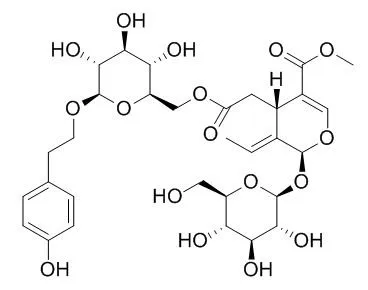| Structure Identification: |
| J Agric Food Chem. 2015 Feb 25;63(7):1990-5. | | Phenolic profile characterization of Chemlali olive stones by liquid chromatography-ion trap mass spectrometry.[Pubmed: 25650173] |
METHODS AND RESULTS:
Aqueous methanol extracts of Chemlali olive stones were analyzed by reverse phase high-performance liquid chromatography (HPLC) with diode array detection and mass spectrometry [LC-MS/MS]. Oleoside, oleoside 11-methyl ester, Nuezhenide, oleoside 11-methyloleoside, Nuezhenide 11-methyloleoside, oleuropein, and glycosides of tryosol and hydroxytyrosol glycosides were identified in stones of Chemali olives. The antioxidant activity observed for the extract of the olive stones (IC50 = 13.84 μg/mL, TEAC = 0.436 mM) may be due to the high content of phenolic compounds, of which the main compounds are Nuezhenide (325.78 mg/100g), methoxy derivative of Nuezhenide (132.46 mg/100g), and Nuezhenide-11-methyloleoside (82.91 mg/100g).
CONCLUSIONS:
These results suggest the use of olive stones as sources of natural antioxidants. | | Journal of Huzhou Teachers College, 1997(6):40-8. | | Studies on the Chemical Constituents of Germinant Inhibitor in the Fruits of Ligustrum Lucidum Ait.[Reference: WebLink] |
Nuezhenzi is the fruit of Ligustrum Lucidum Ait. that belongs in Olive Family. Germinant inhibition of the fruits had been discovered in recent years, and this effect can be applicable to solve some problems of agricultural production. But no any domestic or foreign articles have been pub-lished that discussed what is the main inhibitory constituent in the fruits.
METHODS AND RESULTS:
These studies were done by means of tracking activity , and a white powery compound was isolated from the aqueous substance of the fruits by the fractional extraction and purification method . It was identified as Nuezhenide on the basis of physical - chemical properties and IR. UV. and H1NMR.
CONCLUSIONS:
It was proven that the fruits contain several inhibitors and Nuezhenide is the main inhibitory compound. It shows a clear inhibitory effect to the seeds of wheat and Chinese cabbage in 2.5 × 10-3mol or even more during the observed period. |
|






 Cell. 2018 Jan 11;172(1-2):249-261.e12. doi: 10.1016/j.cell.2017.12.019.IF=36.216(2019)
Cell. 2018 Jan 11;172(1-2):249-261.e12. doi: 10.1016/j.cell.2017.12.019.IF=36.216(2019) Cell Metab. 2020 Mar 3;31(3):534-548.e5. doi: 10.1016/j.cmet.2020.01.002.IF=22.415(2019)
Cell Metab. 2020 Mar 3;31(3):534-548.e5. doi: 10.1016/j.cmet.2020.01.002.IF=22.415(2019) Mol Cell. 2017 Nov 16;68(4):673-685.e6. doi: 10.1016/j.molcel.2017.10.022.IF=14.548(2019)
Mol Cell. 2017 Nov 16;68(4):673-685.e6. doi: 10.1016/j.molcel.2017.10.022.IF=14.548(2019)